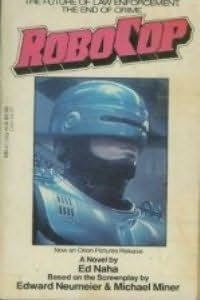If you've read my previous post, you'll know my thoughts on how film and books often have a symbiotic relationship. Books inspire movies, which lead the book's devoted readers to see the adaptation; while on the other hand a film-goer who discovers a new favorite will often go back and read the book, whether they are original works or, in the case of some summer blockbusters, novelizations.
As a thirteen, fourteen year old boy, I loved film novelizations. If I couldn't get one of my parents to take me to see the latest R-rated movie (and, often, I couldn't), then at the very least I could buy the novelization, no ID required, and read Aliens, Predator, or RoboCop. Later, when I did see these movies, on video tape or cable, I was a little disappointed as the films never quite measured up to my own imaginings.
But regardless of whether a book is the original source material or a novelization, publishers are always quick to release tie-in editions — books bearing covers and/or artwork from the film. It was this little tidbit that made me pause in regards to the newest, cinematic version of Gulliver's Travels. For anyone whose ever read the source material, it is pretty evident that this version is a fairly loose adaptation of the original novel — it would probably be more accurate to say “inspired” rather than “based” or “adapted.” Unless there's a considerable amount of scenes missing from the trailer, the filmmakers have chosen not only to modernize the story, but also to focus on the Gulliver's first, and most famous, voyage to Lilliput, ignoring his adventures in Brobdingnag, Laputa, and the Country of the Houyhnhnms. And yet, come the holiday season, when the film will be released, I'm willing to bet that at least one publisher will release a tie-in version of the novel, complete with movie poster cover. To further complicate matters, the same publisher might release a novelization of the film with similar cover art. I remember this happening when Bram Stoker's Dracula, the Francis Ford Coppola version, was released; I was in a bookstore and on the shelf, right next to each other, was the tie-in edition of the original novel and the film novelization. Both had full color inserts with scenes from the movie and both had cover art based on the movie poster. Regardless, of which version you wanted to read, due diligence needed to be exercised to make sure you purchased the right one.
Now, I regress myself to my 14-year-old self, let's say I'm a huge Jack Black fan who loves such movies as School of Rock, Nacho Libre, Tropic Thunder just to name a few, and I watch these films over & over, bits, if not whole tracts, of my everyday conversation are made up of Jack Black quotes. I'm in a bookstore a week or two before Gulliver's Travels (the movie) opens, and I come across the film novelization. After much cajoling, I convince my parent into buying it, I run back to the section, quickly grab the book with the tethered Jack Black cover, and slip it to my mom or dad just as they're making the afternoon purchases. Once home, I crack open the book, only to discover prose of a decidedly seventeenth-century nature and much Swiftian satire. Oops.
Another example is the video game Dante's Inferno, obviously based on the first canticle of The Divine Comedy. Again, liberties have been taken on the part of the game designers to increase the action quotient: Dante is now a crusader returned home, instead of an exiled poet, who must venture through the nine circles of Hell to reclaim the soul of his beloved Beatrice from the hands of Lucifer. The video game has inspired a direct-to-DVD animate film as well as a tie-in edition of the Henry Wadsworth Longfellow translation of Dante's original text, wrapped in the video game's cover art and includes “sixteen pages of stunning art, [about] how the monsters and characters—from King Minos and Cerberus to Lucifer himself—evolved from their classic images to the darkest creatures in damnation, and witness how the environments fashioned by the game's creators bring the tortured netherworld of absolute evil to hideous life.” The game's chief designer writes an introduction for the edition, in which he asks, “Is Dante rolling over in his grave?”
Bait and switch? I wouldn't argue that. After all, tie-ins and novelizations are often pretty clearly marked, if you're paying attention (something my 14-year-old self wasn't always too good at). And, quite honestly, there's much in Swift's original novel that would tickle a 14-year-old, such as when the scene in which Gulliver extinguishes a fire in the Lilliputian Royal Palace. Though I fear, the more likely case would be the book would be returned to the store and exchanged for the novelization, so my 14-year-old self could read what, in a week or two later, will almost exactly be portrayed on the big screen — although probably not quite as good as I had imagined it. While my contemporary self, the one who has read and loved Swift's brilliant novel, can only be disappointed by a Hollywood dilution. It may very well be enjoyable, but I fear I'll miss the depth and humanism of the original for a few moments of mirthful diversion.
--Dan









No comments:
Post a Comment
Thanks for your comment! We love hearing from you.